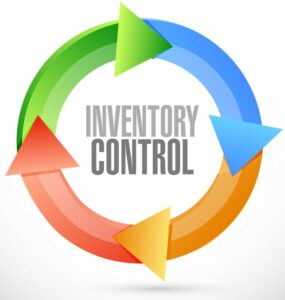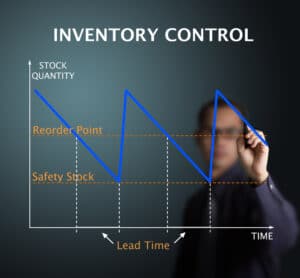Ever shop at Ikea? They boast 12,000 products. You wander through labyrinth of furniture and products to be greeted at the end by a well-organized warehouse laid out in a very neat grid. Even the most scattered shopper can find each and every product by referring to the Aisle and Bin numbers. How many repair shops are this organized?
Inventory is a tricky thing. Not enough you lose sales – too much you lose money. The manufacturing sector combats the issue with Just-In-Time (JIT) inventory processes. Apparatus repair lacks the predictability required for a true JIT system, but automation is generally a big improvement over manual systems. Not all automated systems are created equally, and some e-systems are not very forgiving when it comes to special orders or discontinued items.
We spend a lot of time with customers in their shops. They initially come to us trying to solve problems, and inventory issues often top the list.
Common problems & costs that stem from uncontrolled inventory:

- Inaccurate inventory counts lead to being under or over stocked; both of which cost money.
- Lack of inventory automation (or poor automation) leads to over-committing products or under purchasing.
- Stocking the wrong products or quantities can lead to lost money or sales due to excessive freight charges to have the correct products overnighted to fulfill orders.
- Inability to accurately plan to meet repair schedules.
- Lack of good warehouse/location tracking may lead to similar products being stored in different areas of the shop, which in turn leads to employees over purchasing products when they cannot find them.
- Lack of visibility on available quantities. Just because an item is on the shelf does not necessarily mean it’s available to sell. Can you tell at-a-glance if another sales rep has recently sold a particular item or if it’s already slated to be used in another job?
- Reliance on visual cues for placing orders. How streamlined is your purchasing system?
- Ad hoc monitoring of inventory levels? Excess inventory is expensive. Why put product on the shelf if you are not going to sell it?
Let’s take a look at a few examples:
- You receive a call from a priority customer frantically looking for a 50HP 1800RPM, TEFC, 326T Frame motor needed as a critical replacement for a production machine.
- How quickly can you answer? Do you need to put your customer on hold or call back after you check stock and get pricing?
- Do you know how many units are available now? Are you able to tell if that motor on the shelf is really available or has it already been committed to another customer? Is another one due in on a purchase order?
- Do you know both the cost and price for that motor? Stock Pricing? Customer-specific pricing? What are the freight charges if you need to order it? How quickly can you get the answers?
What if you commit to selling a new motor because you think it’s in stock, but later finds out the one on the shelf had already been sold? How much extra will it cost to overnight another motor to the customer to save the sale and your rapport with your customer?
Alternatively, what if you determine the motor is not in stock but make the sale because you can get it from a local warehouse within a day or two? After making the sale and delivering the motor to the customer you realize that one was in stock after all, but it was on the wrong shelf. At that point you probably begin to wonder just how long that motor had been sitting there… Inventory sitting on the shelf might just as well be a stack of hundred-dollar bills – it’s money on the shelf!
- Are volume discounts always worth the added purchase?
You need to buy 4 brushes for a DC Motor with a cost of $20 each or $80 total. The vendor tells you they are running a deal, and if you buy 8, the price drops to $15 each.
Do you take the deal knowing there is a possibility you’ll never need them again, or do you buy them because that makes the purchase the equivalent of buy 6 get 2 free? Now you may be thinking that you are charging them all to the job and had built in profit, but if that job has already been quoted you didn’t charge enough. $40 of excess inventory just ended up on your shelf, and more often than not we see those brushes in a scrap bin.
Be proactive & get a grip
- Automate your process. Take advantage of systems that simplify inventory tracking. Take a look at the Spring Point Direct Connect with EIS as an option to simplify the process.
- Discontinue items that you no longer stock or make them obsolete, so they are not inadvertently purchased into inventory.
- Monitor excess inventory on a routine basis. Don’t be afraid to send something back even if you end up paying a restocking fee; sometimes that is less expensive than having it sit on your shelf.
- Organize your inventory.
- Prioritize training your inventory manager so they know how to shop the best deals, work well with vendors, and control the inventory. Follow-up on POs. Know when each product is supposed to ship and follow up to ensure it actually shipped on time. Material not coming in as scheduled causes unnecessary delays in repairs.
- Keep vendor scorecards so that you can identify which vendors are best at on-time deliveries.
- Enter meaningful descriptions in your system to make items easier to find.
- Automate the purchasing process with preset minimum available quantity re-order points that generate vendor purchase orders in real-time.

Inventory is tricky. In an ideal world you would have only the products you need and only when and where you need them. Manufacturing companies use JIT to feed a very predictable process. The industrial apparatus service industry does not have the luxury of that type of predictability. Inventory stock is still a necessity. Electronic, on-premises vendor cabinets begin to bring JIT to repair shops, but for now, optimized control is a realistic goal,
What inventory challenges are you facing?
